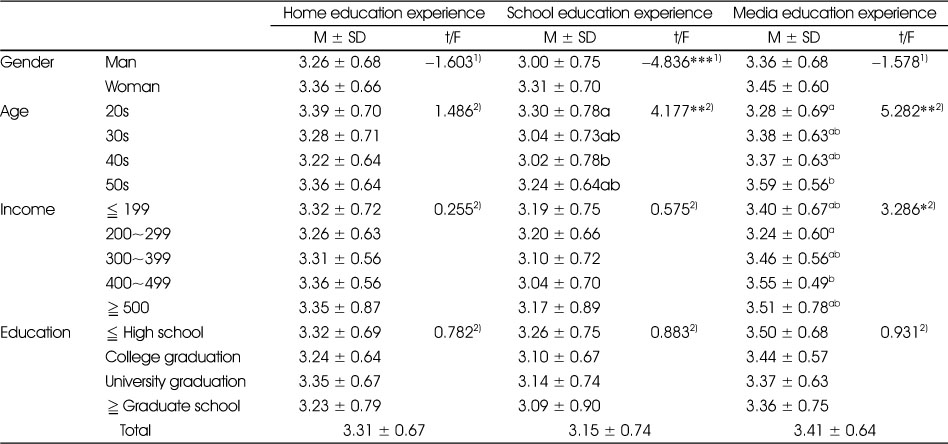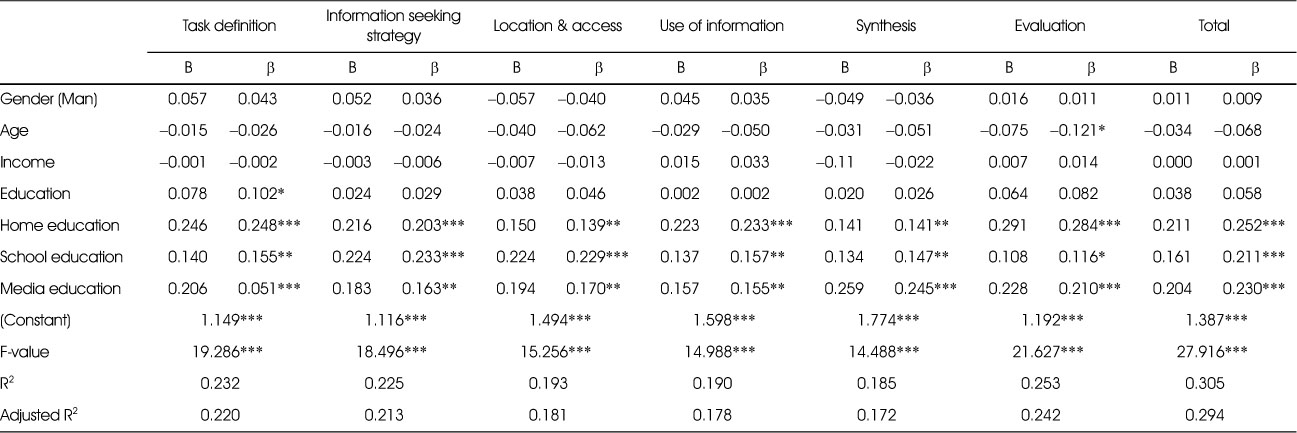Articles
- Page Path
- HOME > Korean J Community Nutr > Volume 24(5); 2019 > Article
-
Research Article
- Effect of Dietary Education Experience (Home, School, and Mass Media) on Food Consumer Information literacy
-
Ji Eun Kim
 , Kyoung Sook Choi
, Kyoung Sook Choi
-
Korean Journal of Community Nutrition 2019;24(5):363-373.
DOI: https://doi.org/10.5720/kjcn.2019.24.5.363
Published online: October 30, 2019
1Department of Home Economics Education, Dongguk University, Gyeongju, Korea, Visiting professor.
2Department of Home Economics Education, Dongguk University, Gyeongju, Korea, Instructor.
- Corresponding author: Kyoung Sook Choi. Department of Home Economics Education, Dongguk University Gyeongju Campus 123, Dongdae-ro, Gyeongju-si, Gyeongsangbuk-do, Korea. Tel: (054) 770-2527, Fax: (054) 770-2528, cks@dongguk.edu
Copyright © 2019 The Korean Society of Community Nutrition
This is an Open-Access article distributed under the terms of the Creative Commons Attribution Non-Commercial License (http://creativecommons.org/licenses/by-nc/3.0/) which permits unrestricted non-commercial use, distribution, and reproduction in any medium, provided the original work is properly cited.
- 140 Views
- 0 Download
- 2 Crossref
Abstract
-
Objectives
- This study examined the effects of dietary education experience (home, school, and mass media) on food consumer information literacy.
-
Methods
- The study subjects were 454 adult consumers who answered a structured questionnaire. The questionnaires addressed the subjects' demographics, dietary education experience (home, school, and mass media), and food consumer information literacy. The data were analyzed through frequency analysis, mean, standard deviation, t-test, ANOVA, Pearson's correlation, and multiple regression analysis using SPSS Win 24.0.
-
Results
- First, the scores of mass media education experience were 3.41 ± 0.64, which was the highest, and 3.15 ± 0.74 for school education experience, which was the lowest. Second, the level of sub-literacies (task definition, information seeking strategy, location and access, use of information, synthesis, and evaluation) showed scores of 3.20 ± 0.72 ~ 3.47 ± 0.68, which were slightly higher than the median. The synthesis literacy was the highest, as opposed to the information seeking strategy literacy, which was the lowest. The location and access and synthesis literacy were higher in women. Third, a significant positive(+) relationship was observed between all sub-literacies and each of three dietary education experiences (home, school and mass media). According to multiple regression analysis, the major variables influencing the sub-literacies of food consumer information literacy were home education, mass media, and school education in that order.
-
Conclusions
- The dietary education experience was the highest through mass media. The factor that showed the highest food consumer information literacy was synthesis. The factors influencing the food consumer information literacy were dietary education experience through home, school, and mass media.
- 1. Park MH, Song IS, Park MS. Consumer decision making (Learning by discussion). Paju: Kyomunsa; 2005. p. 170.
- 2. Eisenberg MB, Berkowitz RE. Information problem-solving: The big six skills approach to library and information skills instruction. 4th ed. Norwood, NJ: Albex publishing; 1996.
- 3. Hwang HS, Kim KO. Consumer information competency of contemporary consumers: Effects on information search efficiency and effectiveness for purchase of electronic goods. Fam Environ Res 2012; 50(6): 99-117.
- 4. Walsh G, Mitchell VW. Demographic characteristics of consumers who find it difficult to decide. Mark Intell Plan 2005; 23(3): 281-295.
- 5. Ahn JI. A study on the age difference of digital media literacy. Korean J Learn Sci 2013; 7(1): 1-21.
- 6. Sung WJ. Study on digital literacy and digital divide in the smart society. Korean Soc Public Adm 2014; 25(2): 53-75.
- 7. Nam SJ. A comparative study on the digital literacy between aged consumers and general consumers: Verification of a moderating effects of gender, education, income, and area. Consum Policy Educ Rev 2013; 9(4): 55-65.
- 8. Koo JO, Park HR, Kim KW. Nutrition education and counselling. 6th ed. Seoul: KNOU press; 2018. p. 3.
- 9. Kim YH. A study on the needs of dietary education of high school students in Daegu and Gyeongbuk province. Korean Home Econ Educ Assoc 2010; 22(4): 77-90.
- 10. Jeon SK. Educational meanings and effective practical plans of school dietary life education. J Korean Home Econ Educ Assoc 2010; 22(1): 117-135.
- 11. Lee SS. Direction of evaluation and contents composition of dietary life area in practical arts curriculum for 2015. J Korean Pract Arts Educ 2016; 29(2): 125-142.
- 12. Jeon SK. An analysis on the observation of the actual condition of dietary life education in school and the demand for dietary life education according to the 2015 revised practical arts curriculum by elementary school teachers. J Korean Pract Arts Educ 2017; 30(1): 21-42.
- 13. Jang YM, Kim YK. Content analysis of food and nutrition unit in middle school textbooks of home economics: focus on the national curriculums from 1st to 2009 revised. J Korean Home Econ Educ Assoc 2018; 30(4): 93-112.
- 14. Kim JH, Woo TJ, Lee KA, Lee SM, Lee KH. Application and the effect of nutrition education program based on the social cognitive theory among middle school girls. Korean J Community Nutr 2016; 21(6): 497-508.
- 15. Baek JY, Yi HY, Hwang JY, Kim KR. Effects of nutrition education program based on social cognitive theory for low sodium consumption among housewives living in certain regions of Seoul. J Korean Soc Food Sci Nutr 2017; 46(10): 1243-1252.
- 16. Joe MY, Hwang JY. Qualitative study on improvement of operating system and tailored nutrition education program for marriage immigrants to Korea: program providers' perspective. Korean J Community Nutr 2017; 22(4): 323-335.
- 17. Park MR, Kim YJ. Effects of eating behavior of preschool children using a direct visual stimulating program on vegetables and nutrition education with vegetable playing. J Korean Diet Assoc 2018; 24(4): 298-311.
- 18. Choi YJ, Kim JH. The influence of elementary students on eating behavior and improving nutrition knowledge according to the development of nutritional education program focusing on integrated cooking activities. Culin Sci Hosp Res 2018; 24(5): 78-89.
- 19. Yoon SY, Yoo HS. The effects of food and nutrition information in mass media on adolescents' dietary behaviors. Korean Soc Integr Med 2016; 4(2): 109-120.
- 20. Hwang DH, Jeon MS. A study on the use of mass media for nutrition knowledge: focusing on Daejeon-Chungnam. Culin Sci Hos Res 2016; 22(4): 95-113.
- 21. Choi JW. Effect of nutritional knowledge and mass media on snack purchase behavior of middle-school students in Seoul area [master's thesis]. Chung-Ang University; 2018.
- 22. Lee KI, Ban HJ, Park KH, Hwang YJ. Development and measurement of the index of agrifood consumer competency index. J Rural Dev 2014; 37(3): 59-77.
- 23. Lee YL. The effect of consumer information literacy and rational cognitive style on consumer confusion [master's thesis]. Sungkyunkwan University; 2018.
- 24. Kim JH, Jeon SK. A study on the systematization of contents and textbooks analysis for school dietary education in elementary school. Fam Environ Res 2010; 48(9): 125-136.
- 25. Kim JW. Paradigm shift to sustainable dietary education from the confusion of dietary education and nutrition education. J Korean Pract Arts Educ 2018; 24(4): 17-37.
- 26. Kim CI, Lee HS, Chang YE, Lee EN, Lee HJ. The Third Korea National Health & Nutrition Examination Survey (KNHANES III), 2005 - Nutrition Survey (I). Sejong: Ministry of Health and Welfare; 2006.
- 27. Moon HK, Jang YJ. Quantitative analysis of food and nutrition informations offered in Television Programs (year 2002-2003): Newscastings, health information programs, and dramas. J Korean Diet Assoc 2005; 11(1): 54-66.
- 28. Kwak JE, Lee SY, Lee SH, Ko SK. A survey for needs and preference of food and nutrition information on mass media for Korean female adults. Korean J Community Nutr 2014; 19(6): 550-557.
- 29. Kim KT. The impact and importance of mass media on the public health. J Nutr Health 1998; 31(4): 8-13.
- 30. Kwon YS, Ju SY. Trends in nutrient intakes and consumption while eating-out among Korean adults based on Korea national health and nutrition examination survey (1998-2012) data. Nutr Res Pract 2014; 8(6): 670-678.
- 31. Park ES. Status and demand of preschool children’s mothers on dietary education. Teach Educ Res 2017; 56(4): 424-435.
- 32. Lee MS, Lee KH. Development and application of dietary education to improve the vegetable intake of preschoolers. J Korean Diet Assoc 2014; 20(1): 26-35.
- 33. Park MY, Park PS. Factors related to eating habits and nutrition status of mother affecting on Body Mass Index of children aged 1-5years: Data from the fifth Korea National Health and Nutrition Examination Survey, 2010-2011. Korean J Community Nutr 2016; 21(1): 102-111.
- 34. Cho HS, Joo HJ. The experience and demands of dietary education in full-time mothers with young children. Korean Soc Early Child Teach Educ 2018; 22(2): 201-231.
- 35. Oh NG, Gwon SJ, Kim KW, Sohn CM, Park HR, Seo JS. Status and need assessment on nutrition & dietary life education among nutrition teachers in elementary, middle, and high schools. Korean J Community Nutr 2016; 21(2): 152-164.
- 36. Yeo SH. The actual condition of nutrition education of nutrition teacher and research of duty change and job stress: focused on Kyung-Sang-Nam-Do Region [master's thesis]. Busan University; 2012.
- 37. Oh EK, Chang HR. Information literacy: Identification of factors affecting undergraduate students. J Korean Lib Inf Sci Soc 2005; 39(4): 207-231.
- 38. Kim HS, Kim JW. Prospective elementary teacher's evalution of dietary life education program for improving their dietary life education, food literacy, and agricultural literacy. J Korean Pract Arts Educ 2016; 22(2): 107-122.
REFERENCES
Figure & Data
REFERENCES
Citations

- Agrifood consumer competency index and food consumption behaviors based on the 2019 Consumption Behaviors Survey for Food
Eun-kyung Kim, Yong-seok Kwon, Da Eun Lee, Hee Jin Jang, Young Hee Park
Journal of Nutrition and Health.2021; 54(2): 199. CrossRef - Healthy Eating Capability of One-person Households-The Effects of Eating Alone, Meal Types, and Dietary Lifestyles
Seonglim Lee, Ilsook Choi, Junghoon Kim
Family and Environment Research.2020; 58(4): 483. CrossRef
Statement of food consumer information literacy
A 5-point Likert scale was used from 1 (strongly disagree) to 5 (strongly agree).
General characteristics of the subjects
n=454
Dietary education according to general characteristics
*: p<0.05, **: p<0.01, ***: p<0.001
A 5-point Likert scale was used from 1 (strongly disagree) to 5 (strongly agree).
1) t- value, 2) F- value
ab: Different superscripts within the same row mean differences by Duncan's post-hoc test(p<0.05).
Food consumer information literacy according to general characteristics
*: p<0.05
1) t-value, 2) F-value
Correlation relationship between dietary education and food consumer information literacy
**: p<0.01
Related variables affecting food consumer information literacy
*: p<0.05, **: p<0.01, ***: p<0.001
A 5-point Likert scale was used from 1 (strongly disagree) to 5 (strongly agree).
n=454
*: p<0.05, **: p<0.01, ***: p<0.001 A 5-point Likert scale was used from 1 (strongly disagree) to 5 (strongly agree). 1) t- value, 2) F- value ab: Different superscripts within the same row mean differences by Duncan's post-hoc test(p<0.05).
*: p<0.05 1) t-value, 2) F-value
**: p<0.01
*: p<0.05, **: p<0.01, ***: p<0.001

 KSCN
KSCN






 PubReader
PubReader Cite
Cite


